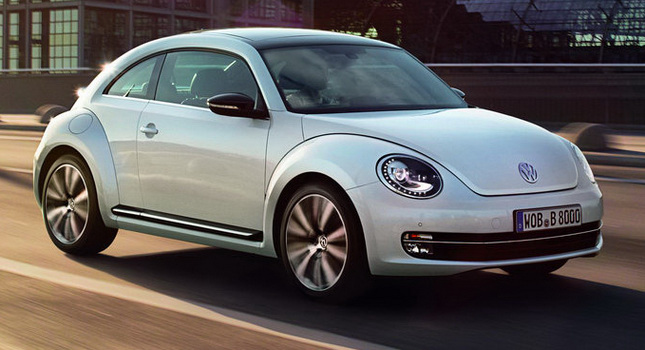Not that the 2012 Beetle needs it, but Volkswagen wants to keep its newcomer in the headlines until it launches into the market this fall starting with the U.S. in September, followed by Germany in October, the rest of Europe in November, the UK in January 2012, Asia in February 2012 and finally South America by the beginning of 2013.
To do so, the German automaker came out today with a fresh batch of images as well some new info explaining some of the thinking behind the creation of the 2012 Beetle.
Although the latest two generations of the Beetle have very few in common with the original model other than the shape and styling details, that’s something to be expected given that the first model was created back in the 1930s. According to VW’s own words, the Beetle’s shape is a classic, like the Coke bottle, the iPhone, the Ray Ban Aviator sunglasses and the Leica M9 camera.
This is a blessing, but also a curse: how do you replace one of the most successful cars of all time, bringing it up to date but at the same time preserving its unique character? The answer to this question, according to VW Group’s design chief Walter de Silva and VW’s Klaus Bischoff, lies in the fact that they both understand what this icon stands for, and set this as their objective: design “a new original”.
Surely, the shape of the new Beetle resembles its predecessors and if you put the original 1938 model next to the new one you’ll see that there are quite a lot of similarities, like the lines of the rear end.
Compared to the 1998 New Beetle, the 2001 Beetle has a 12 mm lower roofline, is substantially wider (by 84 mm) and also longer (by 152 mm). The wheelbase has also grown by 22 mm, to 2,537 mm. The aim was to create a bolder, more masculine car than its predecessor while retaining the Beetle’s character.
A rather unique characteristic of the new model will be the (optional) country-specific badging in the rear according to its nickname in each market: Käfer, Beetle, Vocho, Coccinelle, Fusca, Maggiolino or 甲壳虫. Or, if you prefer something more discreet, just Volkswagen.
The interior also resembles that of the first Beetle, updated of course with carbon look and color-painted surfaces. Also, like the original, the new Beetle has an extra glovebox whose lid folds upward and auxiliary instruments for oil temperature, chronometer function and boost pressure above the audio or navigation system.
Of course the modern interpretation of the cult icon has to conform to today’s norms. Therefore it is offered with a wide range of petrol and diesel engines, with output between 105 and 200 PS, while economy is also a factor: In Europe the most economical Beetle is the 1.6 TDI with an average consumption of just 4.4 lt/100 km and in the US the 2.0 TDI with 33 mpg.
VW Beetle Key Facts
Market launch, North America: September / October 2011
Market launch, Germany: October 2011
Market launch, Europe: November 2011 (right-hand steering version: January 2012)
Market launch, Asia: February 2012
Market launch, South America: end of 2012 / beginning of 2013
Equipment lines: “Beetle”, “Design”, “Sport”
Power range: 77 kW / 105 PS to 147 kW / 200 PS
Combined minimum fuel consumption, Europe: 4.3 l/100 km (1.6 TDI)
Combined fuel economy, USA: 33 mpg (2.0 TDI)
Engine specifications: Petrol engines: TSI (petrol direct injection engines, except 2.5-litre engine for USA). Diesel: TDI (common rail engines). All EU engines fulfill Euro-5 emissions standard; all US engines fulfil BIN5 / ULEV PZEV
Debut of original Beetle:1938
Debut of New Beetle:1998
Total units built to date:> 22.5 million
Designers:Walter de Silva (Group), Klaus Bischoff (Brand). Exterior: Marc Lichte (team leader), Chris Lesmana, Nisan Kucam. Interior: Tomasz Bachorski (team leader), Ingo Brückmann. Colour and Trim: Oona Scheepers (team leader), Susanne Gerken
Dimensions:4,278 mm length, 1,808 mm width, 1,486 mm height, 2,537 mm wheelbase, 310 to 905 litres cargo capacity
PHOTO GALLERY







































